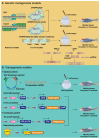Zebrafish Models of Paediatric Brain Tumours
- PMID: 36077320
- PMCID: PMC9456103
- DOI: 10.3390/ijms23179920
Zebrafish Models of Paediatric Brain Tumours
Abstract
Paediatric brain cancer is the second most common childhood cancer and is the leading cause of cancer-related deaths in children. Despite significant advancements in the treatment modalities and improvements in the 5-year survival rate, it leaves long-term therapy-associated side effects in paediatric patients. Addressing these impairments demands further understanding of the molecularity and heterogeneity of these brain tumours, which can be demonstrated using different animal models of paediatric brain cancer. Here we review the use of zebrafish as potential in vivo models for paediatric brain tumour modelling, as well as catalogue the currently available zebrafish models used to study paediatric brain cancer pathophysiology, and discuss key findings, the unique attributes that these models add, current challenges and therapeutic significance.
Keywords: animal models; paediatric brain cancer; zebrafish.
Conflict of interest statement
The authors declare no conflict of interest.
Figures



Similar articles
-
Facing CAR T Cell Challenges on the Deadliest Paediatric Brain Tumours.Cells. 2021 Oct 29;10(11):2940. doi: 10.3390/cells10112940. Cells. 2021. PMID: 34831165 Free PMC article. Review.
-
Paediatric brain tumours treated at a single, tertiary paediatric neurosurgical referral centre from 1999 to 2010 in Australia.J Clin Neurosci. 2012 Oct;19(10):1387-91. doi: 10.1016/j.jocn.2012.01.028. Epub 2012 Aug 14. J Clin Neurosci. 2012. PMID: 22898201
-
Orthotopic Transplantation of Human Paediatric High-Grade Glioma in Zebrafish Larvae.Brain Sci. 2022 May 10;12(5):625. doi: 10.3390/brainsci12050625. Brain Sci. 2022. PMID: 35625011 Free PMC article.
-
Italian cancer figures, report 2012: Cancer in children and adolescents.Epidemiol Prev. 2013 Jan-Feb;37(1 Suppl 1):1-225. Epidemiol Prev. 2013. PMID: 23585445 English, Italian.
-
Pediatric Cancer Models in Zebrafish.Trends Cancer. 2020 May;6(5):407-418. doi: 10.1016/j.trecan.2020.02.006. Epub 2020 Mar 13. Trends Cancer. 2020. PMID: 32348736 Free PMC article. Review.
Cited by
-
Modeling of brain tumors using in vitro, in vivo, and microfluidic models: A review of the current developments.Heliyon. 2024 May 16;10(10):e31402. doi: 10.1016/j.heliyon.2024.e31402. eCollection 2024 May 30. Heliyon. 2024. PMID: 38807869 Free PMC article. Review.
-
Maternal immunization impairs lymphoma growth and CNS/ocular metastasis in the offspring.Front Immunol. 2024 Dec 18;15:1498272. doi: 10.3389/fimmu.2024.1498272. eCollection 2024. Front Immunol. 2024. PMID: 39744643 Free PMC article.
-
Current Landscape of Preclinical Models for Pediatric Gliomas: Clinical Implications and Future Directions.Cancers (Basel). 2025 Jul 2;17(13):2221. doi: 10.3390/cancers17132221. Cancers (Basel). 2025. PMID: 40647519 Free PMC article. Review.
-
Novel insights on genetics and epigenetics as clinical targets for paediatric astrocytoma.Clin Transl Med. 2024 Feb;14(2):e1560. doi: 10.1002/ctm2.1560. Clin Transl Med. 2024. PMID: 38299304 Free PMC article. Review.
-
Epigenetic modifications and their roles in pediatric brain tumor formation: emerging insights from chromatin dysregulation.Front Oncol. 2025 Jun 17;15:1569548. doi: 10.3389/fonc.2025.1569548. eCollection 2025. Front Oncol. 2025. PMID: 40599851 Free PMC article. Review.
References
-
- Anderson D.M., Rennie K.M., Ziegler R.S., Neglia J.P., Robison L.R., Gurney J.G. Medical and neurocognitive late effects among survivors of childhood central nervous system tumors. Cancer Interdiscip. Int. J. Am. Cancer Soc. 2001;92:2709–2719. doi: 10.1002/1097-0142(20011115)92:10<2709::AID-CNCR1625>3.0.CO;2-D. - DOI - PubMed
Publication types
MeSH terms
LinkOut - more resources
Full Text Sources
Medical

